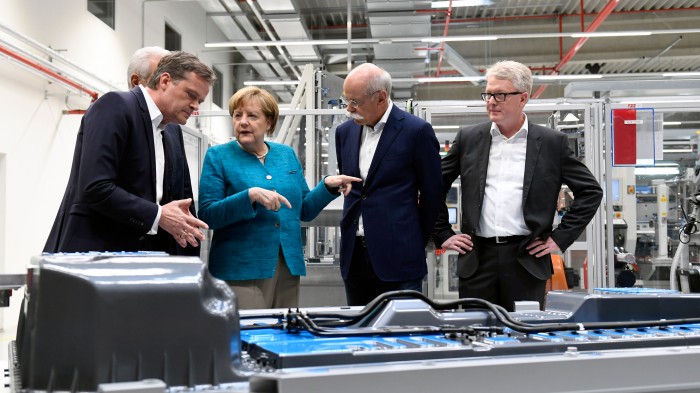Electric Cars Could Be Cheaper Than Internal Combustion by 2030

Battery production is booming, and Tesla is far from the only game in town.
According to Bloomberg New Energy Finance, global battery production is forecast to more than double between now and 2021. The expansion is in turn driving prices down, good news both for the budding electric-car industry and for energy companies looking to build out grid-scale storage to back up renewable forms of energy.
While Tesla gets tons of attention for its “gigafactories”—one in Nevada that will produce batteries, and another in New York that will produce solar panels—the fact is, the company has a lot of battery-building competition.
Exhibit A is a new battery plant in Kamenz, Germany, run by Accumotive. The half-billion-euro facility broke ground on Monday with a visit from German chancellor Angela Merkel and will supply batteries to its parent company, Daimler, which is betting heavily on the burgeoning electric-vehicle market.
But the lion’s share of growth is expected to be in Asia. BYD, Samsung, LG, and Panasonic (which has partnered with Tesla) are all among the world’s top battery producers, and nine of the world’s largest new battery factories are under construction in China (paywall), according to Benchmark Minerals.
That competition means the steady downward trend in battery prices is going to continue. On a per-kilowatt-hour basis, costs have fallen from $542 in 2012 to around $139 today, according to analysis by Benchmark. That makes for a huge difference in the cost of an electric car, of which 40 percent is usually down to the battery itself.
Bloomberg’s analysts have already said that the 2020s could be the decade in which electric cars take off—and one even went so far as to say that by 2030, electric cars could be cheaper than those powered by internal combustion.
Those watching the industry might worry that a flood of cheap batteries could end up hurting profitability for producers, as happened in the solar-panel business. That could happen, but India and China, two huge rising automotive markets, are bullish about using electric cars to help solve problems like traffic congestion and air pollution. So even as supply ramps up, there is likely to be plenty of demand to go around.
(Read more: Bloomberg, Fast Company, “The World’s Largest Electric-Vehicle Maker Hits a Speed Bump,” “The 2020s Could Be the Decade When Electric Cars Take Over”)
Keep Reading
Most Popular
Large language models can do jaw-dropping things. But nobody knows exactly why.
And that's a problem. Figuring it out is one of the biggest scientific puzzles of our time and a crucial step towards controlling more powerful future models.
How scientists traced a mysterious covid case back to six toilets
When wastewater surveillance turns into a hunt for a single infected individual, the ethics get tricky.
The problem with plug-in hybrids? Their drivers.
Plug-in hybrids are often sold as a transition to EVs, but new data from Europe shows we’re still underestimating the emissions they produce.
Stay connected
Get the latest updates from
MIT Technology Review
Discover special offers, top stories, upcoming events, and more.